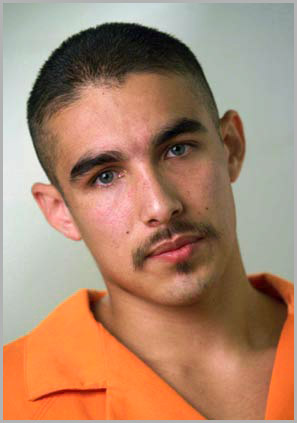|
Pinta Bound
Part 1 2 3
 | Armando Frias Jr. - photo by Janjaap Dekker |
Cap's Saloon is a bar and card room in downtown Salinas, California. On a warm evening in May, 2001, Armando Frias Jr. was there playing pool. Frias was 19 years old and an aspiring member of a gang that controlled drug sales in the area. At Cap's he spotted a man who was in trouble with the gang for selling drugs without sharing his profits. Frias called his street bosses on his cell phone. They met him in the parking lot. They gave him a gun, and he went back inside.
"When I walked in there," says Frias, "I went to the jukebox, came up behind him, and shot him. I thought I hit him in the back of the head and I found out I hit him in the back of the neck."
The victim died at the scene. Armando Frias Jr. was arrested and imprisoned. But the leaders of the group behind the killing were already in prison. Frias was acting on behalf of a powerful Latino prison gang. The group is called "Our Family" - in Spanish, Nuestra Familia, or NF.
"All over Northern California," Frias explains, "you've got these regiments that are being run by the NF, and all these regular street gang members out there selling drugs, they're paying a certain percentage to the NF. They call it paying rent or taxes. That's just the way the NF runs, that's the way they run the streets."
The NF isn't a street gang that's gone to prison. It's a prison gang that's hit the streets. The NF and other prison gangs have flourished in a place designed to shut them down.
At Pelican Bay State Prison, behind a maze of concrete walls, high voltage security fences and steel doors, lies a prison within a prison. It's commonly known as a supermax. The state of California calls this place the Security Housing Unit or SHU.
Most of the inmates in the SHU are gang members. Their cells are windowless and nearly bare. The men are locked inside for 22 and a half hours a day, usually alone. They are held in virtual isolation to try to keep them from working together, but even the SHU can't stop some leaders from running their gangs.
Joseph McGrath was warden at Pelican Bay until 2004.
"The head leaders of the Nuestra Familia, the Mexican Mafia, the Aryan Brotherhood, you name the prison gang, they're in prison," says McGrath. "And they control the activities of the gang both within the prison system and in our communities in California and now unfortunately, have even spread to other states."
Prison gangs that started in California are now in more than 20 states. Recent surveys report more than 300,000 gang members in America's jails and prisons. For convicts like Epitacio Cortina, the prison gang offered a strange kind of career: as teacher, fighter, arch criminal.
"I lived, I breathed, I ate, I slept, I thought the gang," says Cortina.
He is a heavy set, 31-year-old Latino serving 15 years to life for murder. His body is covered with NF tattoos, a black eagle with arched wings on his wrist, the number 14 etched just above his left eye. Cortina spent eight years in the Pelican Bay SHU as a loyal captain in the Nuestra Familia.
"When I became a member of the NF," says Cortina, "I was put in charge of a regiment out on the streets, meaning I was to help oversee that regiment making sure that the members we had out there were generating revenue for the organization in prison."
Cortina says he trained other inmates prior to their parole. Once out of prison, these men ran the gang's criminal network, including street gangs.
"We'd educate them on vocabulary, how to speak properly, how to dress properly, blend in with society so that way you can do your criminal activity on the under. We also educated them on how to do bank robberies, how to do armored car robberies, how to do home invasions."
Cortina says the parolees faced brutal retaliation if they didn't follow the gang's orders. Cortina himself is now in danger because he recently left the gang.
Continue to part 2
| 
